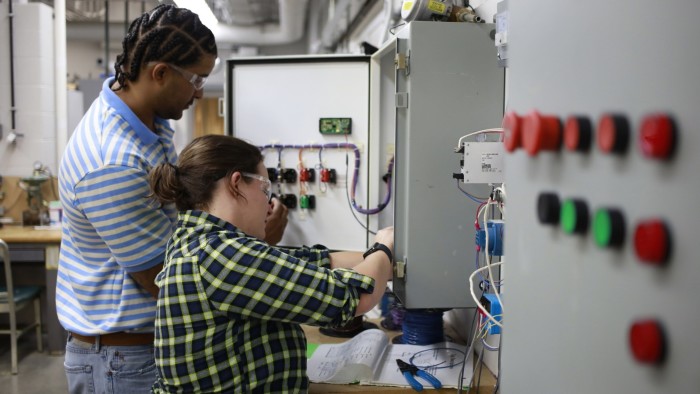Rebuilding US industry via green transition makes no sense

Roula Khalaf, Editor of the FT, selects her favourite stories in this weekly newsletter.
The writer is an FT contributing editor and executive director of American Compass
Having exhausted all other options, US policymakers are finally doing the right thing for domestic manufacturing: embracing industrial policy to channel capital towards expanding the nation’s productive capacity.
Between the Infrastructure Investment and Jobs Act, the Chips and Science Act, and the clean energy programmes in the inaptly named Inflation Reduction Act, hundreds of billions of dollars in public spending and subsidies have prompted a building surge. Spending on US manufacturing construction nearly tripled from mid-2021 to mid-2023 after remaining flat for the previous six years. But celebration of a “manufacturing renaissance”, as US Steel chief executive David Burritt has called the surge, is premature.
Certainly, a policy revolution has occurred. Leaders across the political spectrum have embraced the necessity of a public role in fostering productive investment. Many economists are acknowledging that making things matters in ways markets will ignore.
Just as important, implementation has validated the basic premise that the private sector will respond to industrial policy with investment. This is no small accomplishment. Other policies intended to trigger greater investment — for instance, tax cuts and stimulus spending — failed repeatedly. Now, the semiconductor plants and the battery factories are going up as intended.
That is the good news. The bad news is that the Biden administration’s framework will not go beyond these tentative steps towards a genuine manufacturing renaissance, because it is not designed to.
The problem is most obvious with the IRA, which first and foremost is climate legislation. Stipulating that a reduction in fossil fuel use is the worthiest of goals, it remains fundamentally inconsistent with strengthening US manufacturing. The win-win rhetoric of rebuilding industry via a green transition makes no sense, as should be obvious: if fossil fuels did not have environmental drawbacks, for instance, would a heavily subsidised transition away from them be a savvy strategy for industrial revival? Of course not.
Indeed, putting climate change to the side and considering the green transition purely as industrial strategy, the project is absurd. Manufacturing is energy intensive. Access to a cheap, reliable, abundant supply of fossil fuels — especially natural gas — is one of America’s key competitive advantages.
Development of those abundant fossil fuels is itself among America’s major industrial activities and gives rise to some of its most robust exports. The production of combustion engine vehicles is among the sector’s most significant segments. Yet the IRA succeeds only to the extent that the US abandons its energy advantage and relies upon lower-productivity solar and battery technologies and foreign supply chains.

The irreconcilable tension has come to a head with the United Auto Workers strike against Detroit’s Big Three carmakers, in which the transition to electric vehicles is a central concern. Enthusiastic speeches on “green jobs” could elide trade-offs only so long as policy was not yet forcing them. Pushing the automotive industry towards building more expensive vehicles with less-productive workers, dependent on supply chains dominated by China, has real costs for both US capital and labour.
The Chips push is better. Reclaiming the cutting edge in semiconductors has significant value itself and to the broader sector. But the model does not scale. Washington will write large cheques to fund a finite set of projects in an industry of particular concern, and then what? The US needs an industrial finance authority with a long-term commitment to driving both public and private capital into productive projects sector-wide.
If and when the US moves beyond just spending to achieving sustainable progress, that progress should be visible with clear validation points. Two places to look are labour productivity and the balance of trade in advanced technology products. Both measures have been flashing red during the nation’s industrial decline.
Absolute productivity in the manufacturing sector, not merely its growth rate, has fallen since 2012, including over the past two years. US factories need more workers than a decade ago to produce the same output. This should not be possible in a well-functioning capitalist economy and is incompatible with a thriving industrial base. A return to strong, sustained productivity growth is the sine qua non of a genuine renaissance.
Similarly, the US should aspire to a global competitive edge in advanced technology products, which should appear as an area of export strength and thus generate a favourable balance of trade. This was the case at the outset of globalisation, in the early 1990s. But a $60bn surplus has collapsed to a nearly $200bn deficit (in 2020 dollars). We should demand a reversal of that trend.
The IRA is doomed to failure on both these fronts. It intentionally drives capital and labour into less productive manufacturing processes and greater dependence on imported technology. While its effect thus far underscores that a manufacturing renaissance can be achieved, what remains to be seen is whether the US will do it.

Comments